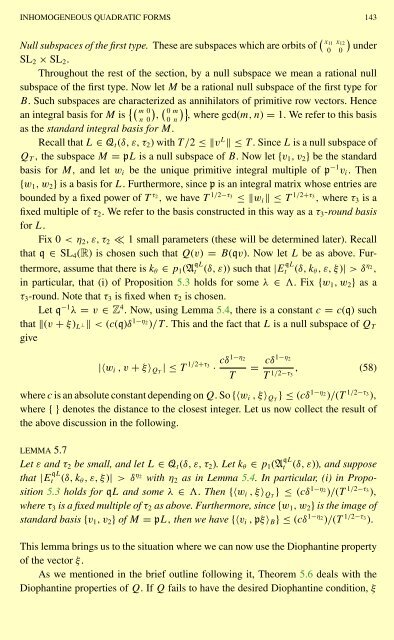NEAR OPTIMAL BOUNDS IN FREIMAN'S THEOREM
NEAR OPTIMAL BOUNDS IN FREIMAN'S THEOREM
NEAR OPTIMAL BOUNDS IN FREIMAN'S THEOREM
You also want an ePaper? Increase the reach of your titles
YUMPU automatically turns print PDFs into web optimized ePapers that Google loves.
<strong>IN</strong>HOMOGENEOUS QUADRATIC FORMS 143<br />
Null subspaces of the first type. These are subspaces which are orbits of x11<br />
0<br />
x12 under<br />
0<br />
SL2 × SL2.<br />
Throughout the rest of the section, by a null subspace we mean a rational null<br />
subspace of the first type. Now let M be a rational null subspace of the first type for<br />
B. Such subspaces are characterized as annihilators of primitive row vectors. Hence<br />
an integral basis for M is m 0 0 m<br />
, , where gcd(m, n) = 1. We refer to this basis<br />
n 0 0 n<br />
as the standard integral basis for M.<br />
Recall that L ∈ Qt(δ, ε, τ2) with T/2 ≤vL≤T.Since L is a null subspace of<br />
QT , the subspace M = pL is a null subspace of B. Now let {v1,v2} be the standard<br />
basis for M, and let wi be the unique primitive integral multiple of p−1vi. Then<br />
{w1,w2} is a basis for L. Furthermore, since p is an integral matrix whose entries are<br />
bounded by a fixed power of T τ2 1/2−τ3 , we have T ≤wi ≤T 1/2+τ3 , where τ3 is a<br />
fixed multiple of τ2. We refer to the basis constructed in this way as a τ3-round basis<br />
for L.<br />
Fix 0 δ η2 ,<br />
in particular, that (i) of Proposition 5.3 holds for some λ ∈ . Fix{w1,w2} as a<br />
τ3-round. Note that τ3 is fixed when τ2 is chosen.<br />
Let q −1 λ = v ∈ Z 4 . Now, using Lemma 5.4, there is a constant c = c(q) such<br />
that (v + ξ)L ⊥ < (c(q)δ1−η2 )/T. This and the fact that L is a null subspace of QT<br />
give<br />
|〈wi ,v+ ξ〉QT |≤T 1/2+τ3 · cδ 1−η2<br />
T<br />
cδ1−η2<br />
=<br />
T 1/2−τ3<br />
, (58)<br />
where c is an absolute constant depending on Q. So {〈wi ,ξ〉QT }≤(cδ 1−η2 )/(T 1/2−τ3 ),<br />
where {}denotes the distance to the closest integer. Let us now collect the result of<br />
the above discussion in the following.<br />
LEMMA 5.7<br />
Let ε and τ2 be small, and let L ∈ Qt(δ, ε, τ2). Letkθ ∈ p1(A qL<br />
t (δ, ε)), and suppose<br />
that |E qL<br />
t (δ, kθ,ε,ξ)| >δ η2 with η2 as in Lemma 5.4. In particular, (i) in Proposition<br />
5.3 holds for qL and some λ ∈ . Then {〈wi ,ξ〉QT }≤(cδ 1−η2 )/(T 1/2−τ3 ),<br />
where τ3 is a fixed multiple of τ2 as above. Furthermore, since {w1,w2} is the image of<br />
standard basis {v1,v2} of M = pL, then we have {〈vi , pξ〉B} ≤(cδ 1−η2 )/(T 1/2−τ3 ).<br />
This lemma brings us to the situation where we can now use the Diophantine property<br />
of the vector ξ.<br />
As we mentioned in the brief outline following it, Theorem 5.6 deals with the<br />
Diophantine properties of Q. If Q fails to have the desired Diophantine condition, ξ

















